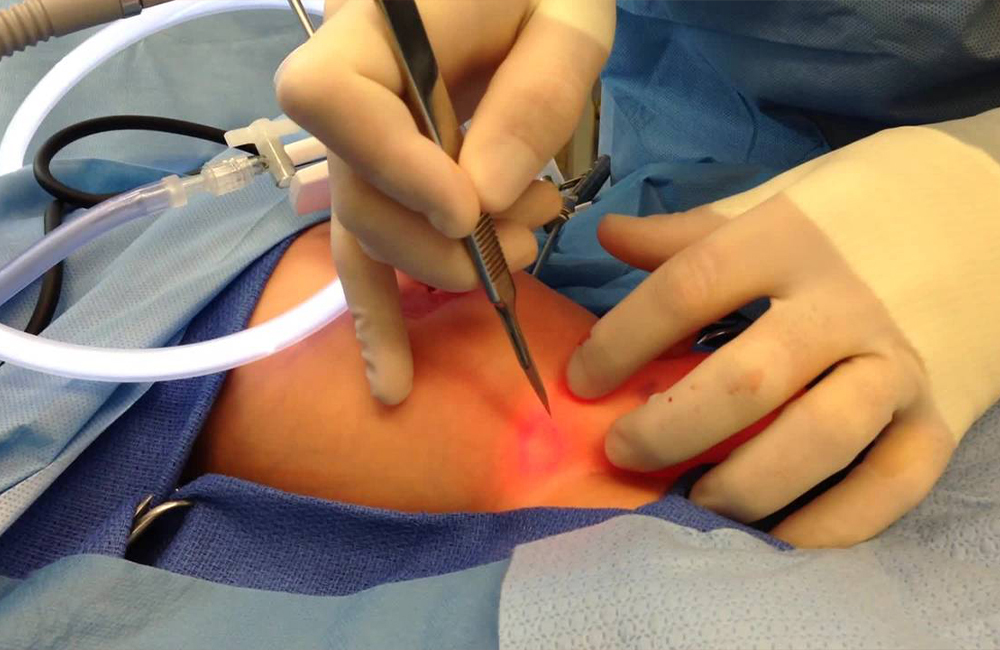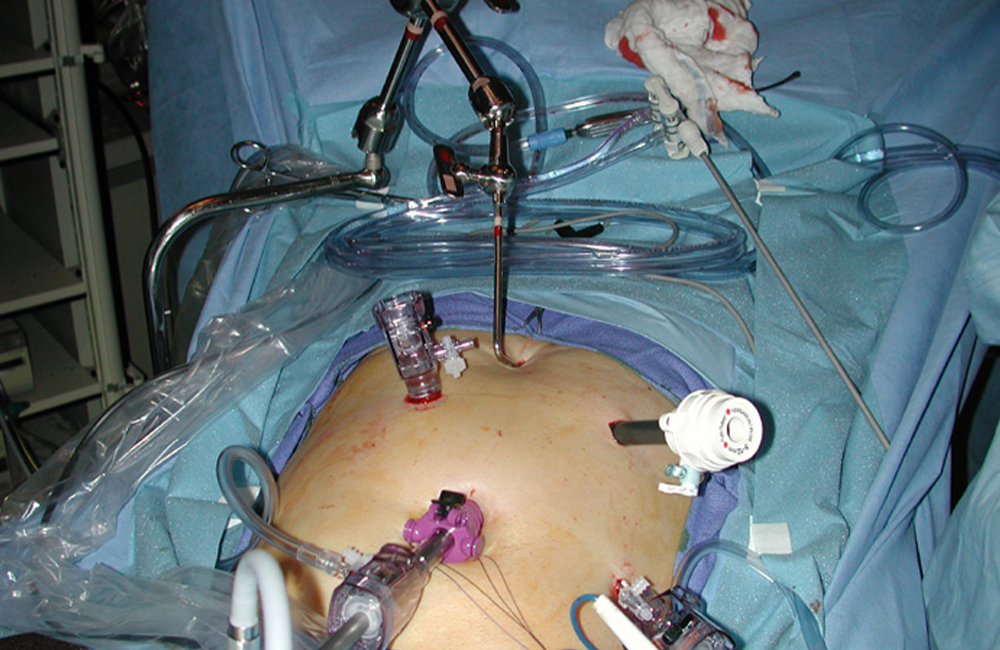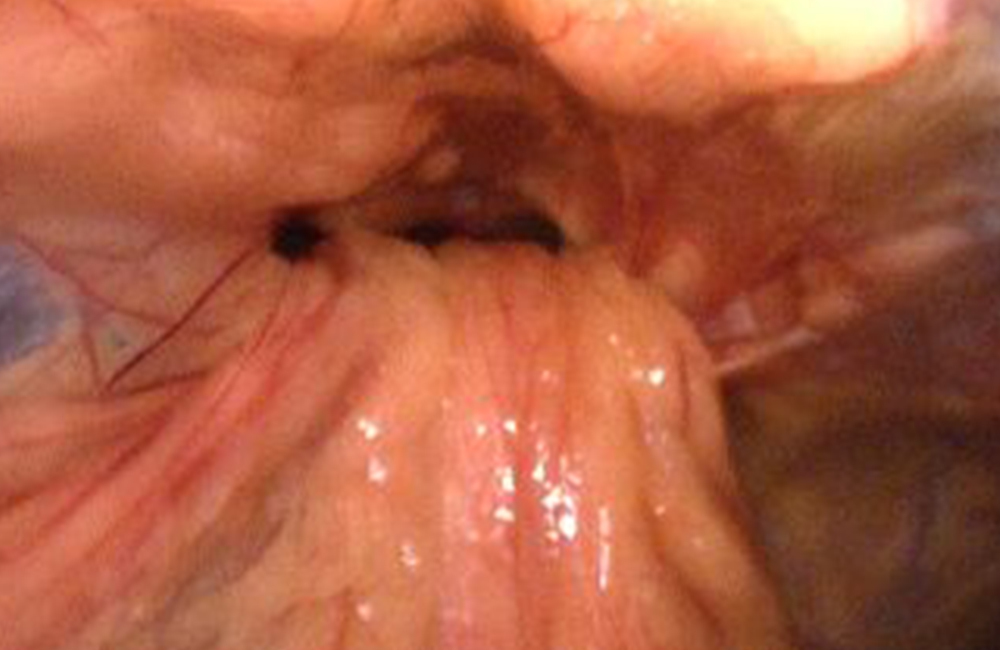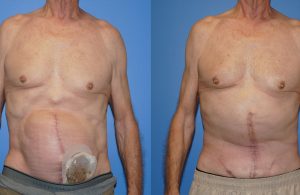Types of
Procedures
- Laparoscopic inguinal Hernia Repair
- Open umbilical hernia repair
- Laparoscopic incisional hernia repair
- Laparoscopic fundoplication
- Laparoscopic Diaphragmatic Hernia Repair
- Abdominal wall Reconstruction
 This type of surgery uses a few small incisions and a thin scope with a tiny camera. The surgeon works through the scope to repair the hernia. Synthetic mesh may also be used in Laparoscopic hernia surgery. Recovery time after laparoscopy may be shorter than for open repair.
This type of surgery uses a few small incisions and a thin scope with a tiny camera. The surgeon works through the scope to repair the hernia. Synthetic mesh may also be used in Laparoscopic hernia surgery. Recovery time after laparoscopy may be shorter than for open repair.
 Under general anesthesia, a small incision is made in the umbilicus (belly button). The Loop of intestine is placed back into the abdominal cavity, and the incision closed. Sometimes a piece of mesh material is used to help strengthen the area where the muscles are repaired.
Under general anesthesia, a small incision is made in the umbilicus (belly button). The Loop of intestine is placed back into the abdominal cavity, and the incision closed. Sometimes a piece of mesh material is used to help strengthen the area where the muscles are repaired.
 ln this minimally invasive surgical procedure, the surgeon makes several small incisions in the Lower abdomen and first inserts a tube-Like instrument, called a Laparoscope, equipped with a camera into one of the incisions. The internal images are displayed on a Large monitor that the surgeon uses to guide small instruments inserted through the other incisions to repair the hernia.
ln this minimally invasive surgical procedure, the surgeon makes several small incisions in the Lower abdomen and first inserts a tube-Like instrument, called a Laparoscope, equipped with a camera into one of the incisions. The internal images are displayed on a Large monitor that the surgeon uses to guide small instruments inserted through the other incisions to repair the hernia.
 Laparoscopic fundoplication is a keyhole procedure performed for patients with severe acid reflux, Barrett’s oesophagus and symptomatic hiatus hernias that no Longer respond to medication. lt is done to prevent acid from the stomach traveling the wrong way into the oesophagus. The operation is predominantly Laparoscopic although very occasionally, conversion to open surgery may be necessary.
Laparoscopic fundoplication is a keyhole procedure performed for patients with severe acid reflux, Barrett’s oesophagus and symptomatic hiatus hernias that no Longer respond to medication. lt is done to prevent acid from the stomach traveling the wrong way into the oesophagus. The operation is predominantly Laparoscopic although very occasionally, conversion to open surgery may be necessary.
 Performed by Laparoscopy, with the advent of minimal access techniques, the usage of open surgical repair for this hernia has decreased and results are comparable along with early recovery and less hospital stay.
Performed by Laparoscopy, with the advent of minimal access techniques, the usage of open surgical repair for this hernia has decreased and results are comparable along with early recovery and less hospital stay.

Apollo lnstitutes of Hernia Surgery & Abdominal Wall Reconstruction specializes in the management of all types of hernia, ranging from small simple hernia to complex large recurrent hernias. Abdominal wall reconstruction is used to treat any open wounds in the abdominal wall after surgery by restructuring the tissues, and reinforcing the integrity of the muscles.
Laparoscopic hernia repair is a technique to fix defects in the abdominal wall using small incisions, Laparoscopes (small telescopes inserted into the abdomen) and a patch (mesh) to reinforce the abdominal wall.
AWR procedures require patients to stay in the hospital for approximately five days following the reconstructive procedure. Patients can return to their daily activities within two to five weeks and can start exercising three months after surgery.
 This type of surgery uses a few small incisions and a thin scope with a tiny camera. The surgeon works through the scope to repair the hernia. Synthetic mesh may also be used in Laparoscopic hernia surgery. Recovery time after laparoscopy may be shorter than for open repair.
This type of surgery uses a few small incisions and a thin scope with a tiny camera. The surgeon works through the scope to repair the hernia. Synthetic mesh may also be used in Laparoscopic hernia surgery. Recovery time after laparoscopy may be shorter than for open repair.
 Under general anesthesia, a small incision is made in the umbilicus (belly button). The Loop of intestine is placed back into the abdominal cavity, and the incision closed. Sometimes a piece of mesh material is used to help strengthen the area where the muscles are repaired.
Under general anesthesia, a small incision is made in the umbilicus (belly button). The Loop of intestine is placed back into the abdominal cavity, and the incision closed. Sometimes a piece of mesh material is used to help strengthen the area where the muscles are repaired.
 ln this minimally invasive surgical procedure, the surgeon makes several small incisions in the Lower abdomen and first inserts a tube-Like instrument, called a Laparoscope, equipped with a camera into one of the incisions. The internal images are displayed on a Large monitor that the surgeon uses to guide small instruments inserted through the other incisions to repair the hernia.
ln this minimally invasive surgical procedure, the surgeon makes several small incisions in the Lower abdomen and first inserts a tube-Like instrument, called a Laparoscope, equipped with a camera into one of the incisions. The internal images are displayed on a Large monitor that the surgeon uses to guide small instruments inserted through the other incisions to repair the hernia.
 Laparoscopic fundoplication is a keyhole procedure performed for patients with severe acid reflux, Barrett’s oesophagus and symptomatic hiatus hernias that no Longer respond to medication. lt is done to prevent acid from the stomach traveling the wrong way into the oesophagus. The operation is predominantly Laparoscopic although very occasionally, conversion to open surgery may be necessary.
Laparoscopic fundoplication is a keyhole procedure performed for patients with severe acid reflux, Barrett’s oesophagus and symptomatic hiatus hernias that no Longer respond to medication. lt is done to prevent acid from the stomach traveling the wrong way into the oesophagus. The operation is predominantly Laparoscopic although very occasionally, conversion to open surgery may be necessary.
 Performed by Laparoscopy, with the advent of minimal access techniques, the usage of open surgical repair for this hernia has decreased and results are comparable along with early recovery and less hospital stay.
Performed by Laparoscopy, with the advent of minimal access techniques, the usage of open surgical repair for this hernia has decreased and results are comparable along with early recovery and less hospital stay.
 Apollo lnstitutes of Hernia Surgery & Abdominal Wall Reconstruction specializes in the management of all types of hernia, ranging from small simple hernia to complex large recurrent hernias. Abdominal wall reconstruction is used to treat any open wounds in the abdominal wall after surgery by restructuring the tissues, and reinforcing the integrity of the muscles. Laparoscopic hernia repair is a technique to fix defects in the abdominal wall using small incisions, Laparoscopes (small telescopes inserted into the abdomen) and a patch (mesh) to reinforce the abdominal wall. AWR procedures require patients to stay in the hospital for approximately five days following the reconstructive procedure. Patients can return to their daily activities within two to five weeks and can start exercising three months after surgery.
Apollo lnstitutes of Hernia Surgery & Abdominal Wall Reconstruction specializes in the management of all types of hernia, ranging from small simple hernia to complex large recurrent hernias. Abdominal wall reconstruction is used to treat any open wounds in the abdominal wall after surgery by restructuring the tissues, and reinforcing the integrity of the muscles. Laparoscopic hernia repair is a technique to fix defects in the abdominal wall using small incisions, Laparoscopes (small telescopes inserted into the abdomen) and a patch (mesh) to reinforce the abdominal wall. AWR procedures require patients to stay in the hospital for approximately five days following the reconstructive procedure. Patients can return to their daily activities within two to five weeks and can start exercising three months after surgery.
Advantages
- Most Advanced Technology & Techniques
- Rapid Recovery & Short Hospital Stay
- Excellent Functional Outcomes
- Low Rate of Hernia Recurrence
- Less Pain
Procedure
Procedures under Abdominal Wall Reconstruction (AWR)
- ETep (Enhanced view Totally extra peritoneal) Repair
- Component Separation Techniques : Transverse Abdominis Release (TAR) etc
- Progressive Preoperative Pneumoperitoneum (PPP)
- Botulinum Injection

